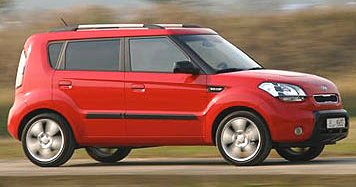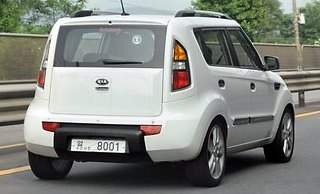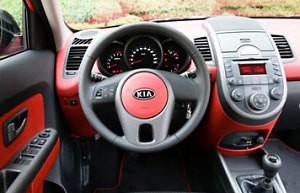Published
on 22
Oct 2008
|
All rights reserved.
|
|
|

|
Soul does not intend to be a
conventional supermini hatchback. Kia wants it to appear funky and
fashionable...
|
Korean
car makers want to depar from cheap cars manufacturing. As any
marketing executives can tell, the only way to earn more profit is to
build your brand image and add higher value into your cars. To do that,
Kia hired a very experienced design chief called Peter Schreyer from
Volkswagen-Audi. He upgraded the design capability of Kia and started
introducing some really interesting designs, such as Cee’d and
Procee’d. These designs did not break the molds set by European
leaders, but they can be seen as a solid starting base that pave the
way for more radical designs to come. And here it is…
Soul does not intend to be a conventional supermini hatchback. Kia
wants it to appear funky and fashionable, the two elements that
previous Kias have yet to attempt. Very much like a Mini or Fiat 500,
buyers can customize their Soul with tough plastic body clad, fancy
design wheels, spoilers, chromed details, color coded interior and many
interior features. Hopefully this will earn extra money for Kia.
Besides, the Soul is designed to be a tall body, supermini-SUV
crossover to attract young people. Its high-set bonnet, side air
vents and blackened roof pillars are designed to appear like Range
Rover. Ground clearance is 45 mm higher than conventional hatchbacks,
while seating position is 135 mm higher to give a commanding view over
the road, therefore successfully hides its supermini nature.

|
Very much like Nissan Cube and Toyota
bB...
|
The Soul is
very
tall, predictably. Luckily, it has wide tracks and a stiff suspension
setting to keep body roll tightly controlled. The new platform
underpinning it will be shared with the forthcoming Hyundai i20 and a
future Kia supermini, though everything seems conventional. Its
handling and steering are reasonably good rather than remarkable. Ride
quality is poor on rough surfaces due to the stiff suspensions. As a
result, the optional 225/45 R18 tires are best to be avoided.
Considering the power units it offers, there is no need for such
aggressive rubbers. The most powerful engine is a 2.0-liter 16V VVT
with 142 horsepower. It is unusually large (and thirsty) for this
class. European car makers would not equip a 2.0 engine into a
supermini. Kia did this perhaps because the Soul is rather heavy (from
1210-1285 kg). Anyway, I don’t think this engine has too much advantage
over the 126hp 1.6 turbo diesel, which is torquey, refined and far more
frugal. The base 1.6 petrol with 126hp feels difficult to cope with its
weight. Therefore only one engine worth considering.

|
High driving position offers SUV-like
commanding view...
|
The best
aspect of
Soul is not its driving dynamics or looks, but the cabin. Although it
can’t match European superminis for quality plastics, it has superior
space. It can easily accommodate 6 ft 2 in guys both front and rear,
thanks to the long wheelbase and tall roof. Admittedly, this car is
larger and heavier than other superminis. The interior design is also
fresh, funky and well layout. You can have some interesting features
like “glow fabrics” and very good sound system (with MP3 / USB
connection of course). Boot space is normal, but the back seat are easy
to fold flat to expand cargo capacity.
All these make Kia Soul like Nissan Cube or Toyota bB. They do not
shine in dynamics and quality, but they are spacious, versatile,
gimmicky and funky. Korean has always been following the footprints of
Japanese. This is just another example. |
Verdict:     |
|
|
Specifications
|
|
|
|
|
|
Soul
1.6
|
2008
|
| Front-engined, FWD |
| Steel monocoque |
| Mainly steel |
| 4105 / 1785 / 1610 mm |
| 2550 mm |
Inline-4
|
| 1591 cc |
DOHC 16 valves, VVT
|
| - |
| - |
| 126 hp |
| 115 lbft |
5-speed manual
|
F: strut
R: torsion-beam
|
| - |
| 205/55R16 |
1170 kg
|
| 110 mph (c) |
9.7**
|
| - |
|
Soul 1.6CRDi
|
2008
|
| Front-engined, FWD |
| Steel monocoque |
| Mainly steel |
| 4105 / 1785 / 1610 mm |
| 2550 mm |
Inline-4, diesel
|
| 1582 cc |
DOHC 16 valves
|
VTG turbo
|
| CDI |
| 128 hp |
| 188 lbft |
5-speed manual
|
F: strut
R: torsion-beam
|
| - |
| 205/55R16 |
1270 kg
|
| 113 mph (c) |
10.0 (c)
|
| - |
|
Soul
2.0
|
2008
|
| Front-engined, FWD |
| Steel monocoque |
| Mainly steel |
| 4105 / 1785 / 1610 mm |
| 2550 mm |
Inline-4
|
| 1975 cc |
DOHC 16 valves, VVT
|
| - |
| - |
| 142 hp |
| 137 lbft |
5-speed manual
|
F: strut
R: torsion-beam
|
| - |
| 205/55R16 |
1285 kg
|
| 117 mph (est) |
7.9*
|
| 26.9* |
|
|
|
|
|
Performance
tested by: *C&D, **Autocar
|
|
|
|
|
|
|
Soul 1.6GDi
|
2012
|
| Front-engined, FWD |
| Steel monocoque |
| Mainly steel |
| 4120 / 1785 / 1610 mm |
| 2550 mm |
Inline-4
|
| 1591 cc |
DOHC 16 valves, DVVT
|
| VIM |
| DI |
| 140 hp |
| 123 lbft |
6-speed manual or
6-speed automatic
|
F: strut
R: torsion-beam
|
| - |
| 205/55R16 |
1170 kg
|
| 115 mph (c) |
6M: 9.8 (c)
6A: 8.9*
|
6A: 35.3*
|
|
Soul 2.0
|
2012
|
| Front-engined, FWD |
| Steel monocoque |
| Mainly steel |
| 4120 / 1785 / 1610 mm |
| 2550 mm |
Inline-4
|
| 1999 cc |
DOHC 16 valves, DVVT
|
| - |
| - |
| 165 hp |
| 148 lbft |
6-speed manual or
6-speed automatic
|
F: strut
R: torsion-beam
|
| - |
| 205/55R16 |
1265 (M) / 1335 (A) kg
|
| 122 mph (est) |
6M: 7.4*
6A: 8.2*
|
6M: 23.3*
6A: 25.8*
|
|
|
|
|
|
|
| Performance
tested by: *C&D |
|
|
|
|
|